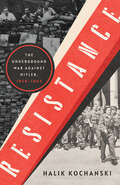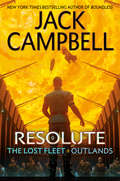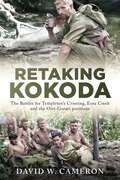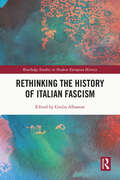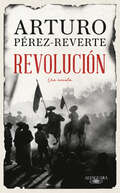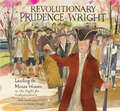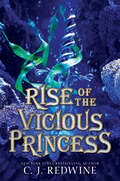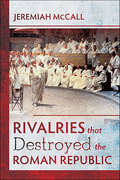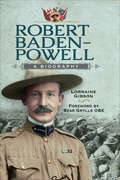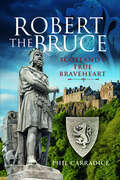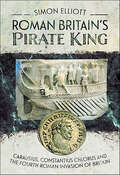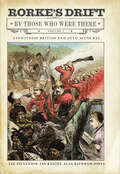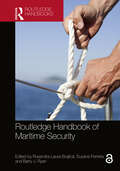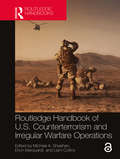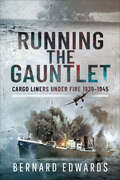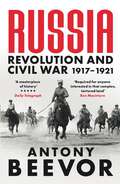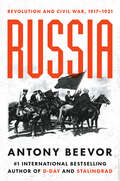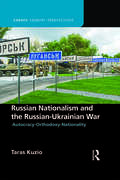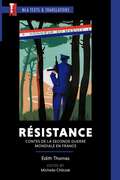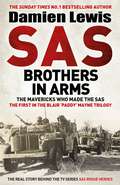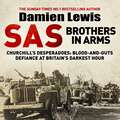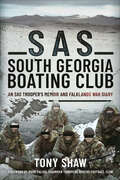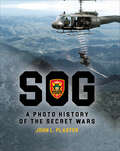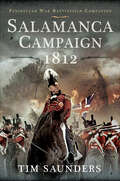- Table View
- List View
Resistance: The Underground War Against Hitler, 1939-1945
by Halik Kochanski“This is the most comprehensive and best account of resistance I have read. It addresses the story with scholarly objectivity and an absolute lack of sentimentality. So much romantic twaddle is still published . . . it is marvelous to read a study of such breadth and depth, which reaches balanced judgments.” —Max Hastings, The Sunday Times (UK) Resistance is the first book of its kind: a monumental history that finally integrates the many resistance movements against Nazi hegemony in Europe into a single, sweeping narrative of defiance. “To resist, therefore. But how, when and where? There were no laws, no guidelines, no precedents to show the way . . .” —Dutch resister Herman Friedhoff In every country that fell to the Third Reich during the Second World War, from France in the west to parts of the Soviet Union in the east, a resistance movement against Nazi domination emerged. And every country that endured occupation created its own fiercely nationalist account of the role of homegrown resistance in its eventual liberation. Halik Kochanski’s panoramic, prodigiously researched work is a monumental achievement: the first book to strip these disparate national histories of myth and nostalgia and to integrate them into a definitive chronicle of the underground war against the Nazis. Bringing to light many powerful and often little-known stories, Resistance shows how small bands of individuals took actions that could lead not merely to their own deaths, but to the liquidation of their families and their entire communities. As Kochanski demonstrates, most who joined up were not supermen and superwomen, but ordinary people drawn from all walks of life who would not have been expected—least of all by themselves—to become heroes of any kind. Kochanski also covers the sheer variety of resistance activities, from the clandestine press, assistance to Allied servicemen evading capture, and the provision of intelligence to the Allies to the more violent manifestations of resistance through sabotage and armed insurrection. For many people, resistance was not an occupation or an identity, but an activity: a person would deliver a cache of stolen documents to armed partisans and then seamlessly return to their normal life. For Jews under Nazi rule, meanwhile, the stakes at every point were life and death; resistance was less about national restoration than about mere survival. Why resist at all? Who is the real enemy? What kind of future are we risking our lives for? These and other questions animated those who resisted. With penetrating insight, Kochanski reveals that the single quality that defined resistance across borders was resilience: despite the constant arrests and executions, resistance movements rebuilt themselves time and time again. A landmark history that will endure for decades to come, Resistance forces every reader to ask themselves yet another question, this distinct to our own times: “What would I have done?”
Resolute (The Lost Fleet: Outlands #2)
by Jack CampbellA Nominee for the 2022 Dragon Award for Best Military Science Fiction or Fantasy Admiral John &“Black Jack&” Geary must battle dangers both within and without the Alliance, in this exciting continuation of the New York Times bestselling series.Geary knows that some political factions in the Alliance were just trying to get rid of him when he was assigned to escort a diplomatic and scientific mission to the far reaches of humanity&’s expansion into the galaxy . . . and beyond. But he views his mission as both a duty and an opportunity to make things better wherever he can. And when a crippled Rift Federation ship tumbles out of jump space, Geary leaps into action. But the survivors&’ story isn&’t completely adding up. As Geary investigates, he soon finds himself fending off spies and assassins while leading the fleet as it fights its way across space controlled by the mysterious and hostile aliens whom humans call enigmas. Challenges arrive at every turn, including an unknown alien species that invites the fleet to visit one of their star systems. With little information to go on, Geary must weigh the benefits of potential new allies against the possibility of a trap. The fate of the fleet—and perhaps even the future of humanity—will depend on him making the right decision. If he can stay alive long enough to do that.
Retaking Kokoda: The Battles for Templeton's Crossing, Eora Creek and the Oivi-Gorari positions
by David W. CameronJapanese Major General Horii Tomitarô, commanding the South Seas Force, had the Australians on the back foot. Australia was holding the last defendable ridge in the Owen Stanley ranges, Imita Ridge. Horii to his distress was then given orders from Imperial Headquarters in Tokyo that he was to fall back across the mountains to the Japanese beachheads at Gona, Sanananda, and Buna, leaving a force between Templeton’s Crossing and Eora Creek to stop any Australian advance through the mountains. The Japanese, unknown to the Australians evacuated Ioribaiwa Ridge just before they launched their attacks and to their amazement on storming the heights, the Australians encountered no resistance – the Japanese had gone. <p><p> This, however, did not mean the fighting on the Kokoda Track was over, far from it. Three more desperate actions would be fought by the Australians and Japanese, before the decisive battles for the Japanese beachheads could be decided – the battles for Templeton’s Crossing, Eora Creek, and finally the Oivi-Gorari positions on the northern lowland plains. Just 15-kilometres east lay the Kumusi River, the last geographical barrier before reaching the strongly fortified Japanese beachheads themselves.
Rethinking the History of Italian Fascism (Routledge Studies in Modern European History)
by Giulia AlbaneseIn the last years, the discussion around what is fascism, if this concept can be applied to present forms of politics and if its seeds are still present today, became central in the political debate. This discussion led to a vast reconsideration of the meaning and the experience of fascism in Europe and is changing the ways in which scholars of different generations look at this political ideology and come back to it and it is also changing the ways in which we consider the experience of Italian fascism in the European and global context. The aim of the book is building a general history of Fascism and its historiography through the analysis of 13 different fundamental aspects, which were at the core of Fascist project or of Fascist practices during the regime. Each essay considers a specific and meaningful aspect of the history of Italian fascism, reflecting on it from the vantage point of a case study. The essays thus reinterrogates the history of Fascism to understand in which way Fascism was able to mould the historical context in which it was born, how and if it transformed political, cultural, social elements that were already present in Italy. The themes considered are violence, empire, war, politics, economy, religion, culture, but also antifascism and the impact of Fascism abroad, especially in the Twenties and at the beginnings of the Thirties. The book could be both used for a general public interested in the history of Europe in the interwar period and for an academic and scholarly public, since the essays aim to develop a provocative reflection on their own area of research.
Revolución: Una novela
by Arturo Pérez-ReverteLA NUEVA NOVELA DE ARTURO PÉREZ-REVERTE Un hombre, tres mujeres y una revolución. Un viaje al corazón humano y a la aventura. «La etapa creativa que está atravesando Arturo Pérez-Reverte resulta asombrosa. ¿[Revolución es] la mejor novela de Pérez-Reverte? Al menos y sin duda, una de las mejores».Sergio Vila-Sanjuán, La Vanguardia Ésta es la historia de un hombre, tres mujeres, una revolución y un tesoro. La revolución fue la de México en tiempos de Emiliano Zapata y Francisco Villa. El tesoro fueron quince mil monedas de oro de a veinte pesos de las denominadas maximilianos, robadas en un banco de Ciudad Juárez el 8 de mayo de 1911. El hombre se llamaba Martín Garret Ortiz y era un joven ingeniero de minas español. Todo empezó para él ese mismodía, cuando desde su hotel oyó un primer disparo lejano. Salió a la calle para ver qué ocurría y a partir de ese momento su vida cambió para siempre... Revolución es mucho más que una novela sobre los dramáticos acontecimientos que sacudieron la república mexicana en el primer tercio del siglo XX. Es un relato de iniciación y madurez a través del caos, la lucidez y la violencia: el asombroso descubrimiento de las reglas ocultas que determinan el amor, la lealtad, la muerte y la vida. «Toda la vida escuché en mi casa la historia de aquel amigo de mi bisabuelo, ingeniero de minas, que trabajó en México en plena revolución. Ese recuerdo remoto me ha aproximado a mi propia relación con la aventura y me ha llevado a escribir esta historia. Es una novela de iniciación y aprendizaje y es, de algún modo, mi propia biografía de juventud. Es mi Flecha de oro ».Arturo Pérez-Reverte «Un libro de grandes balconajes literarios provisto con las honduras adecuadas para sumergirse en el terreno de la aventura, pero también de los grandes valores, donde los lugares comunes que guardamos sobre el bien y el mal se desvanecen y las líneas habituales que los separa se vuelven grises y confusas.[...] Una narración vertiginosa».Javier Ors, El Debate «Heroísmo, valentía, la seducción ante los abismos del peligro, el coraje, la camaradería, la impronta de situaciones extremas en la idiosincrasia del ser humano… Son los elementos intrínsecos de la literatura épica de Arturo Pérez-Reverte y todos ellos están presentes en Revolución.[...][Un autor] volcánico».David Barreira, El Español «Pérez-Reverte se cruza las cananas al pecho, se deja mostacho, y llega a las librerías al galope con Revolución,[donde] el lector encontrará todos los ingredientes que le han convertido en un superventas mundial».Grego Casanova, Vozpópuli «Algo teata firmemente a un lugar al que has sobrevivido y, aunque el autor ha sobrevivido a varios, en México tuvo que hacerlo a golpe de tequila. Algo se torció en una cantina y solo el destilado apaciguó los ánimos y le permitió llegar a los 71 años que está a punto de cumplir».María Paredes, The Objective «Un clásico vivo. Algunos le han comparado con Dumas o Verne [...]. Su maestría narrativa incluye una perspectiva estoica de la existencia, una trágica conformidad con las leyes de la naturaleza, una celebración de la vida en lo que tiene de juego y riesgo».Rafael Narbona, El Cultural «La etapa creativa que está atravesando Arturo Pérez-Reverte resulta asombrosa. ¿[Revolución es] la mejor novela de Pérez-Reverte? Al menos y sin duda, una de las mejores».Sergio Vila-Sanjuán, La Vanguardia «Una historia fiel a sus constantes».José María Pozuelo Yvancos, ABC
Revolutionary Prudence Wright: Leading the Minute Women in the Fight for Independence
by Beth AndersonHere is the first-ever picture book about female Revolutionary War activist Prudence Wright, who rallied the first and only group of "minute women" to fight the British, changing history in the process.Prudence Wright had a spark of independence. Annoyed when the British king held back freedoms in colonial Massachusetts, feisty and fearless Prudence had enough. She said no! to British goods, determined to rely on her resourcefulness and ingenuity to get by. And when British troops continued to threaten the lives of her family and community, she assembled and led the "minute women" of Pepperell to break free of tradition. This untold story of a courageous and brave woman from the Revolutionary War continues to inspire today.
Rise of the Vicious Princess
by C. J. RedwineThe first in a YA political fantasy duology about a fierce princess determined to bring lasting peace to her kingdom regardless of the cost to her heart—from C.J. Redwine, the author of the Defiance series and the New York Times bestselling Ravenspire series. Perfect for fans of These Violent Delights, And I Darken, and Ash Princess.Princess Charis Willowthorn is the dutiful sword of Calera. Raised to be ruthless and cunning, her only goal is to hold her war-torn kingdom together long enough to find a path toward peace with their ancient foe Montevallo, even if the cost is her own heart.When violence erupts in the castle itself, nearly killing the queen, Charis must assume her mother’s duties and manage both the war and her kingdom. But as an unseen enemy begins sinking Calera’s ships, Charis realizes a threat much greater than Montevallo is coming for her people. So she forms a plan.By day, she is Calera’s formidable princess intent on forging an alliance with Montevallo. By night, she disguises herself as a smuggler and roams the sea with a trusted group of loyalists, hunting for their new enemies. And through it all, there's the one boy she can't have—who guards her life, but steals her heart.But her enemies are much closer than Charis realizes, and her heart isn’t the only thing she has left to lose.
Rivalries that Destroyed the Roman Republic
by Jeremiah McCallThis is the story of how some Roman aristocrats grew so competitive in their political rivalries that they destroyed their Republic, in the late second to mid-first century BCE. Politics had always been a fractious game at Rome as aristocratic competitors strove to outshine one another in elected offices and honors, all ostensibly in the name of serving the Republic. And for centuries it had worked - or at least worked for these elite and elitist competitors. Enemies were defeated, glory was spread round the ruling class, and the empire of the Republic steadily grew. When rivalries grew too bitter, when aristocrats seemed headed toward excessive power, the oligarchy of the Roman Senate would curb its more competitive members, fostering consensus that allowed the system—the competitive arena for offices and honors, and the domination of the Senate—to continue. But as Rome came to rule much of the Mediterranean, aristocratic competitions grew too fierce; the prizes for winning were too great. And so, a series of bitter rivalries combined with the social and political pressures of the day to disintegrate the Republic. This is the story of those bitter rivalries from the senatorial debates of Fabius and Scipio, to the censorial purges of Cato; from the murders of Tiberius and Gaius Gracchus, to the ultimate rivalry of Caesar and Pompey. A work of historical investigation, Rivalries that Destroyed the Roman Republic introduces readers not only to the story of the Republic's collapse but the often-scarce and problematic evidence from which the story of these actors and their struggles is woven.
Robert Baden-Powell: A Biography
by Lorraine GibsonRobert Baden-Powell was Britain’s first celebrity. A conflicted character - militarist and pacifist, macho man and drag artist, elitist and socialist - he was one of the 20th century’s most influential and, latterly, controversial Englishmen, finding fame not once, but twice – and for two very different reasons. Before donning his trademark shorts, the man known for inventing the Scouts is hailed a hero of the Second Boer War, the first military conflict covered in great detail by the media. Reports of his unconventional methods of holding a Boer army at bay, despite being woefully outnumbered, at the South African town of Mafeking, make global headlines and when he returns home to England, hordes of adoring fans pack London’s streets, waving flags and declaring him the Hero of Mafeking. The same ingenuity, reconnaissance skills and spectacular eccentricity that win him this military acclaim become the foundations of his second mission, that of saving Victorian boys from poverty and despair, and himself from having to grow up, by teaching them scouting. A youth movement is born which today boasts 54 million members throughout the world. This book examines Baden-Powell’s dual personality, or his ‘two lives’ as he called them, including his difficult childhood with a domineering and unaffectionate mother whom he loved even after she forced him into the army at 19, dashing his dreams of becoming an artist. It looks at his military career and his love of drama and at why protesters wanted to topple his statue on Poole Quay in the pandemic summer of 2020. It also considers a recently-discovered telegraph that adds fuel to the speculation over the nature of his relationship with a fellow-soldier that endured for 30 years - until he married a 22-year-old woman in secret when he was 55. Baden-Powell achieved great prominence, as well as notoriety, in both his military and scouting lives, driven largely by a constant yearning to win his mother’s approval.
Robert the Bruce: Scotland's True Braveheart
by Phil CarradiceRobert the Bruce is a detailed account of the life and times of the Scottish hero and monarch. It covers his life from childhood to death, looking at the political, social and military life of Scotland before, during and after the time of Robert the Bruce. The book looks at the relationship between The Bruce and people like Edward I and Edward II of England, William Wallace and the other contenders for the Scottish crown. The main thrust of the book is a chronological account of how The Bruce clawed his way to power, his struggles and battles and his eventual victory which gave Scotland independence and freedom from an acquisitive and warlike neighbour. It looks in detail at the murder of John Comyn, of which The Bruce stood accused, and the political ramifications of the killing. Robert the Bruce was no saint. He was a ruthless, cunning warrior, a man of his times, dedicated to what he saw as his mission in life. Flawed he may have been but he was also a great King, a worthy warrior and a man who deserves to emerge from the shadow of William Wallace - a position to which he has been relegated ever since the film Braveheart.
Roman Britain's Pirate King: Carausius, Constantius Chlorus and the Fourth Roman Invasion of Britain
by Simon ElliottIn the mid-3rd century AD Roman Britain’s regional fleet, the Classis Britannica, disappeared. It was never to return. Soon the North Sea and English Channel were over-run by Germanic pirates preying upon the east and south coast of Britain, and the continental coast up to the Rhine Delta. The western augustus (senior emperor) Maximian turned to a seasoned naval leader called Marcus Aurelius Mausaeus Valerius Carausius to restore order. He was so successful that Maximian accused him of pocketing the plunder he’d recaptured, ordering his execution. The canny Carausius moved first and in 286 usurped imperial authority, creating a North Sea empire in northern Gaul and Britain which lasted until 296. Dubbed the pirate king, he initially thrived, seeing off early attempts by Maximian to defeat him. However, in the early 290s Maximian appointed his new caesar (junior emperor), Constantius Chlorus (the father of Constantine the Great), to defeat Carausius. A seasoned commander, Constantius Chlorus soon brought northern Gaul back into the imperial fold, leaving Carausius controlling only Britain. Carausius was then assassinated and replaced by Allectus, his treasurer. Allectus was in turn defeated by Constantius Chlorus in AD 296 in the fourth Roman invasion of Britain, the caesar arriving just in time to prevent London being sacked by Allectus’ Frankish mercenaries. Once more Britain was part of the Roman Empire.
Rorke's Drift By Those Who Were There, Volume 1: Eyewitness British and Zulu Accounts
by Ian Knight Lee Stevenson Alan Baynham-Jones“The great host came steadily on, spreading out spreading out - spreading out till they seemed like a giant pair of nut-crackers opening round the little nut of Rorke’s Drift.” – Surgeon Major James Henry Reynolds V.C., Army Medical Department On 22 January 1879, during the final hour of the Battle of iSandlwana – one of the greatest disasters ever to befall British troops during the Victorian era – a very different story was about to unfold a few miles away at the mission station of Rorke’s Drift. When a Zulu force of more than 3,000 warriors turned their attention to the small outpost, defended by around 150 British and Imperial troops, the odds of the British surviving were staggeringly low. The British victory that ensued, therefore, would go down as one of the most heroic actions of all time, and has enraptured military history enthusiasts for decades. Featuring a wide range of first-hand accounts and testimonies from those present during the Battle of Rorke’s Drift, Rorke’s Drift By Those Who Were There is a remarkable work of Anglo-Zulu military history by those who know the topic best, Lee Stevenson and Ian Knight. This updated edition of the classic work of the same name includes even more first-person accounts from the combatants on both the British and Zulu sides. Providing personal, microscopic accounts of events, while at the same time presenting a clear overview of the battle in its entirety, readers will gain an impressive, unique breadth of knowledge about one of the most awe-inspiring battles in British history.
Routledge Handbook of Maritime Security
by Ruxandra-Laura BoşilcăThis handbook offers a critical and substantial analysis of maritime security and documents the most pressing strategic, economic, socio-cultural and legal questions surrounding it. Written by leading international experts, this comprehensive volume presents a wide variety of theoretical positions on maritime security, detailing its achievements and outlining outstanding issues faced by those in the field. The book includes studies which cover the entire spectrum of activity along which maritime security is developing, including, piracy, cyber security, energy security, terrorism, narco-subs and illegal fishing. Demonstrating the transformative character and potential of the topic, the book is divided into two parts. The first part exhibits a range of perspectives and new approaches to maritime security, and the second explores emerging developments in the practice of security at sea, as well as regional studies written by local maritime security experts. Taken together, these contributions provide a compelling account of the evolving maritime security environment, casting fresh light on theoretical and empirical aspects. The book will be of much interest to practitioners and students of maritime security, naval studies, security studies, maritime history, and International Relations in general.
Routledge Handbook of Maritime Security
by Susana Ferreira Barry J. Ryan Ruxandra-Laura BoşilcăThis handbook offers a critical and substantial analysis of maritime security and documents the most pressing strategic, economic, socio-cultural and legal questions surrounding it. Written by leading international experts, this comprehensive volume presents a wide variety of theoretical positions on maritime security, detailing its achievements and outlining outstanding issues faced by those in the field. The book includes studies which cover the entire spectrum of activity along which maritime security is developing, including, piracy, cyber security, energy security, terrorism, narco-subs and illegal fishing. Demonstrating the transformative character and potential of the topic, the book is divided into two parts. The first part exhibits a range of perspectives and new approaches to maritime security, and the second explores emerging developments in the practice of security at sea, as well as regional studies written by local maritime security experts. Taken together, these contributions provide a compelling account of the evolving maritime security environment, casting fresh light on theoretical and empirical aspects.The book will be of much interest to practitioners and students of maritime security, naval studies, security studies, maritime history, and International Relations in general.
Routledge Handbook of U.S. Counterterrorism and Irregular Warfare Operations
by Michael A. Sheehan; Erich Marquardt; Liam CollinsThis handbook comprises essays by leading scholars and practitioners on the topic of U.S. counterterrorism and irregular warfare campaigns and operations around the globe. Terrorist groups have evolved substantially since 9/11, with the Islamic State often described as a pseudo-state, a terrorist group, and insurgency all at the same time. While researchers', analysts', and policymakers’ understanding of terrorism has grown immensely over the past two decades, similar advancements in the understanding of counterterrorism lag. As such, this handbook explains why it is necessary to take a broader view of counterterrorism which can, and often does, include irregular warfare. The volume is divided into three thematic sections: Part I examines modern terrorism in the Islamic world and gives an overview of the major terrorist groups from the past three decades; Part II provides a wide variety of case studies of counterterrorism and irregular warfare operations, spanning from the 1980s to the irregular warfare campaign against the Islamic State in northern Syria in 2018; Part III examines the government instruments used to combat terrorism and wage irregular warfare, such as drones, Theater Special Operations Commands, and Theater Commands. The handbook fills a gap in the traditional counterterrorism literature by its inclusion of irregular warfare and by providing analyses from academic experts as well as practitioners. It will be of much interest to students of counterterrorism, counterinsurgency, U.S. national security, military affairs, and International Relations. The Open Access version of this book, available at https://www.routledge.com/Routledge-Handbook-of-US-Counterterrorism-and-Irregular-Warfare-Operations/Sheehan-Marquardt-Collins/p/book/9780367758363, has been made available under a Creative Commons Attribution-Non Commercial-No Derivatives 4.0 license.
Running the Gauntlet: Cargo Liners Under Fire 1939–1945
by Bernard EdwardsThe British Merchant Navy dominated the world trade routes in the years leading up to the Second World War. The star players of the fleet were the cargo liners, faster and larger than the tramps and offering limited passenger accommodation. On the outbreak of war these cargo liners became crucial to the nation’s survival using their speed and expertise to evade Nazi warships, raiders and U-boats. Initially operating alone, but increasingly relying on Royal Navy protected convoys, these key elements of the Merchant Navy plied the oceans and seas despite mounting losses, throughout the war years. This superbly researched book describes numerous dramatic incidents. Some ended in disaster such as the New Zealand Shipping Company’s Turakina which was sunk after a running battle with the German raider Orion. Others were triumphs for example Operation Substance when six fast cargo liners succeeded against all the odds in reaching besieged Malta with vital supplies. The common denominations in all these historic voyages were the courage and skilled seamanship of the Merchant Navy crews. As Running The Gauntlet vividly illustrates, their contribution to victory, too long overlooked, cannot be overstated.
Russia: Revolution and Civil War 1917-1921
by Antony Beevor'The book is a masterpiece' The Spectator'A gripping narrative history of one of the most complex episodes in modern Russian history' Sunday Times'Antony Beevor's Russia is a masterpiece of history' Daily TelegraphBetween 1917 and 1921 a devastating struggle took place in Russia following the collapse of the Tsarist empire. Many regard this savage civil war as the most influential event of the modern era. An incompatible White alliance of moderate socialists and reactionary monarchists stood little chance against Trotsky's Red Army and Lenin's single-minded Communist dictatorship. Terror begat terror, which in turn led to even greater cruelty with man's inhumanity to man, woman and child. The struggle became a world war by proxy as Churchill deployed weaponry and troops from the British empire, while armed forces from the United States, France, Italy, Japan, Poland and Czechoslovakia played rival parts. Using the most up to date scholarship and archival research, Antony Beevor, author of the acclaimed international bestseller Stalingrad, assembles the complete picture in a gripping narrative that conveys the conflict through the eyes of everyone from the worker on the streets of Petrograd to the cavalry officer on the battlefield and the woman doctor in an improvised hospital.
Russia: Revolution and Civil War, 1917-1921
by Antony Beevor&“Riveting . . . There is a wealth of new information here that adds considerable texture and nuance to his story and helps to set Russia apart from previous works.&”—The Wall Street JournalAn epic new account of the conflict that reshaped Eastern Europe and set the stage for the rest of the twentieth century.Between 1917 and 1921 a devastating struggle took place in Russia following the collapse of the Tsarist empire. The doomed White alliance of moderate socialists and reactionary monarchists stood little chance against Trotsky&’s Red Army and the single-minded Communist dictatorship under Lenin. In the savage civil war that followed, terror begat terror, which in turn led to ever greater cruelty with man&’s inhumanity to man, woman and child. The struggle became a world war by proxy as Churchill deployed weaponry and troops from the British empire, while contingents from the United States, France, Italy, Japan, Poland, and Czechoslovakia played rival parts. Using the most up to date scholarship and archival research, Antony Beevor assembles the complete picture in a gripping narrative that conveys the conflict through the eyes of everyone from the worker on the streets of Petrograd to the cavalry officer on the battlefield and the doctor in an improvised hospital.
Russian Nationalism and the Russian-Ukrainian War (Europa Country Perspectives)
by Taras KuzioThis book is the first to provide an in-depth understanding of the 2014 crisis, Russia’s annexation of Crimea and Europe’s de facto war between Russia and Ukraine. The book provides a historical and contemporary understanding behind President Vladimir Putin Russia’s obsession with Ukraine and why Western opprobrium and sanctions have not deterred Russian military aggression. The volume provides a wealth of detail about the inability of Russia, from the time of the Tsarist Empire, throughout the era of the Union of Soviet Socialist Republics (USSR), and since the dissolution of the latter in 1991, to accept Ukraine as an independent country and Ukrainians as a people distinct and separate from Russians. The book highlights the sources of this lack of acceptance in aspects of Russian national identity. In the Soviet period, Russians principally identified themselves not with the Russian Soviet Federative Republic, but rather with the USSR as a whole. Attempts in the 1990s to forge a post-imperial Russian civic identity grounded in the newly independent Russian Federation were unpopular, and notions of a far larger Russian ‘imagined community’ came to the fore. A post-Soviet integration of Tsarist Russian great power nationalism and White Russian émigré chauvinism had already transformed and hardened Russian denial of the existence of Ukraine and Ukrainians as a people, even prior to the 2014 crises in Crimea and the Donbas. Bringing an end to both the Russian occupation of Crimea and to the broader Russian–Ukrainian conflict can be expected to meet obstacles not only from the Russian de facto President-for-life, Vladimir Putin, but also from how Russia perceives its national identity.
Résistance: Contes de la Seconde Guerre mondiale en France (Texts and Translations #34)
by Édith ThomasBased on real events of the French Resistance during World War II, Édith Thomas's stories explore how ordinary people respond to the extraordinary conditions of political occupation. The stories, first published under the title Contes d'Auxois by an underground press in 1943, were written to oppose Vichy-Nazi propaganda and to offer encouragement to civilians who felt resigned to defeat.Whether lining up to wait for food, tuning in to a forbidden radio broadcast, adapting to living side by side with German soldiers, or preparing for an act of sabotage, the characters in these stories must make choices in highly compromised circumstances on a daily basis. As the characters confront their own suffering and that of others, their actions inspire readers to consider the nature of heroism, the idea that people can share a common humanity with their enemies, and the possibility for individuals to find solidarity in an overwhelming, isolating world.
SAS Brothers in Arms: Churchill's Desperadoes: Blood-and-Guts Defiance at Britain's Darkest Hour.
by Damien LewisDamien Lewis's new bestseller tells the action-packed, riveting story of the band of mavericks and visionaries who made the SAS. Using hitherto untold stories and new archival sources, Damien Lewis follows one close-knit band of warriors from the SAS foundation through to the Italian landings - chronicling the extraordinary part they played as the tide of the Second World War truly turned in the Allied's favour. This is a narrative of wall-to-wall do-or-die action and daring, chronicling the exploits of some of the most highly-decorated soldiers of the twentieth-century.
SAS Brothers in Arms: Churchill's Desperadoes: Blood-and-Guts Defiance at Britain's Darkest Hour.
by Damien LewisThe riveting birth story of the SAS.Damien Lewis's new bestseller tells the action-packed, riveting story of the band of mavericks and visionaries who made the SAS. Using hitherto untold stories and new archival sources, Damien Lewis follows one close-knit band of warriors from the SAS foundation through to the Italian landings - chronicling the extraordinary part they played as the tide of the Second World War truly turned in the Allied's favour.This is a narrative of wall-to-wall do-or-die action and daring, chronicling the exploits of some of the most highly-decorated soldiers of the twentieth-century.(P) 2022 Quercus Editions Ltd
SAS South Georgia Boating Club: An SAS Trooper's Memoir and Falklands War Diary
by Tony ShawMany aspire to serve with the Special Air Service, arguably the world’s most prestigious regiment, but few achieve their aim. In this inspiring memoir the author describes how he left school without any qualifications and embarked on a 30 year career much of it spent in Hereford, including four years in ‘The Regiment’. Against the odds he rose through the ranks before being commissioned and eventually retiring as a Major. Initially attached to 22 SAS as a signaller, he volunteered for and passed ‘Selection’, the most gruelling and demanding of tests. He was posted to D Squadron Boat Troop with whom he saw active service in the Falklands War, Northern Ireland and the UK counter-terrorist team. Thanks to the diary he kept during the Falklands War, the reader is treated to a gripping first-hand account of the intense action that he and his colleagues experienced, including recces, diversionary attacks, raids and ambushes both on South Georgia and the Falklands Islands. Later he commanded the Royal Signals troop supporting D Squadron, 22 SAS before commissioning and later on pursuing a second career as a security consultant in various Middle Eastern hotspots. It is a privilege to read this commendably modest account of one man’s unique career which provides a fascinating insight into elite special forces soldiering.
SOG: A Photo History of the Secret Wars
by John L. PlasterNew edition: The classic illustrated history of the special ops unit—&“an unprecedented look into this little-known aspect of the Vietnam conflict&” (American Rifleman). In 1972 the U.S. military destroyed all known photos of the top-secret Studies and Observations Group, with the intention that details could never be made public. But unknown to those in charge, SOG veterans had brought back with them hundreds of photographs of SOG in action and would keep them secret for more than three decades. In this new edition of SOG: A Photo History, more than 700 irreplaceable photos bring to life the stories of SOG legends Larry Thorne, Bob Howard, Dick Meadows, George Sisler, &“Q&” and others, and document what really happened deep inside enemy territory: Operation Tailwind, the Son Tay raid, SOG&’s defense of Khe Sanh, Hatchet Force operations, Bright Light rescues, HALO insertions, string extractions, SOG&’s darkest programs, and much more.
Salamanca Campaign 1812 (Peninsular War Battlefield Companion)
by Tim SaundersAfter a gap of two years, the 1812 Salamanca Campaign saw Wellington taking the offensive in Spain against Marshal Marmont’s Army of Portugal. Marching from the border fortress of Ciudad Rodrigo which fell to the Allies in January, neither commander was willing to take the risk of a general action without a clear tactical advantage. The result were stand-offs as Wellington offered battle on the San Christóbal Heights, but once the small French-garrisoned forts left behind in Salamanca fell, Marmont withdrew to the Douro. For over a week the two armies shared cooling waters of the river before Marmont ‘humbugged’ Wellington and fell on the Allied left flank at Castrejón. Wellington rushed to the aid of the Light and 4th divisions with the heavy cavalry. Over the following days Marmont dexterously manoeuvred Wellington back towards Salamanca, with both armies within cannon shot still not risking battle. When it seemed Wellington would have to march back to the safety of Portugal, Marmont finally made a mistake on the plains south of Salamanca on 22 July 1812, by allowing his army to become over extended. Wellington saw what was happening and after weeks of marching and counter marching, the battle the soldiers earnestly hoped for was on. In the past it has been difficult to place the fighting on the ground in the centre of the Salamanca battlefield, where ‘vast clouds of smoke and dust that rolled along the basin’ obscured vision even for those fighting. Supplementing their letters, diaries and memoires with modern geographical aids, archaeology and a stout pair of boots, it is now possible to reconcile the sequence of the battle with locations, in a way in which it was not feasible even a few years ago.
